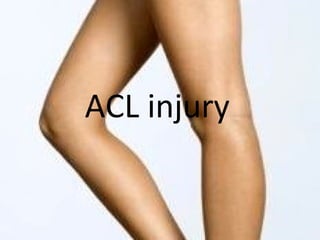
Anterior Cruciate ligament Injury
- 1. ACL injury
- 2. Normal Knee
- 3. Bone &Joint &Ligaments & Cartilage
- 4. Muscle &Tendon Hamstring muscle Quadriceps muscle
- 5. Movement of the knee
- 6. How injury occurred? • A sudden stop, twist • Extreme hyperextension • Direct contact
- 8. Severity • Grade I A mild injury that causes only microscopic tears in the ACL. Although these tiny tears may stretch the ligament out of shape, they do not affect the overall ability of the knee joint to support your weight. • Grade II A moderate injury in which the ACL is partially torn. The knee can be somewhat unstable and can "give away" periodically when you stand or walk. • Grade III A severe injury in which the ACL is completely torn through and the knee feels very unstable. Most ACL injuries are severe Grade III 10% - 28% being either Grade I or Grade II.
- 9. ACL injuries usually combined • With the menisci (50 %) • With articular cartilage (30 %), • With collateral ligaments (30%), • In football players and skiers, consists of injuries to the ACL, the MCL and the medial meniscus. In cases of combined injuries, surgical treatment may be warranted and generally produces better outcomes
- 10. The four "classic" symptoms when the ACL is torn • Hear a "pop" from inside the knee • Feel the knee give away at the time of injury • Swollen immediately, or within a few hours • Severe pain can not continue play
- 11. The diagnosis of an ACL tear • Physical examination – Lachman test – Pivot shift test • X-Ray • MRI MRI of complete ACL tear
- 12. Treatment for ACL injuries • Immediately after injury – R.I.C.E ( Rest Ice Compression Elevation () • Non surgical treatment – Exercise (after swelling decreases and weight- bearing progresses) – Braces • Rehabilitation Brace • Functional Brace • Surgical treatment
- 13. Rehab Total Range of Motion • Ideal for total knees, meniscus repairs, regenerative chondroplasty , ligament surgeries and patella real ignments, • Range of motion control and short cuffs for extended rehabilitation.
- 14. Hinge functional knee braces • Have rigid metal supports down the si des of the brace to r educe knee instabilit y following injury.
- 15. Non surgical Treatment • Isolated ACL tears – With partial tears and NO instability symptoms – With complete tears and NO symptoms of knee instability during low-demand sports who are willing to give up high- demand sports – Who do light manual work or live sedentary lifestyles – Whose growth plates are still open (children)
- 16. Non surgical Precautions • Modification of active lifestyle to avoid high demand activities • Muscle strengthening exercises for life • May require knee brace • Despite above precautions ,secondary damage to knee cartilage & meniscus leading to premature arthritis
- 18. Surgical Intervention and Considerations • ACL tears are not repaired using suture • Replaced by a graft made of tendon • Long-term success rates of over 95 percent • The goal is – prevent instability – restore the function of the torn ligament – allows the patient to return to sports • Not performed until several weeks after the injury – To allows the swelling decreases, inflammation subsides, and range of motion improves
- 19. Patient Considerations • Active adult patients: consider surgical treatment • Young children or adolescents: delay ACL surgery until the child is closer to skeletal maturity if necessary should modify the ACL surgery technique
- 20. The grafts commonly used • Autograft – Patellar tendon – Hamstring tendon – Quadriceps tendon • Allograft (from a cadaver) – Patellar tendon, – Achilles tendon, – Semitendinosus, – Gracilis, or posterior tibialis tendon
- 23. Graft harvested & reconstructed ACL
